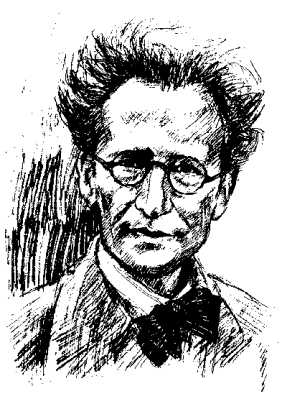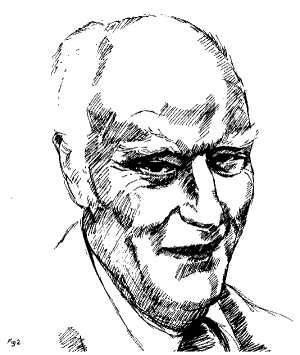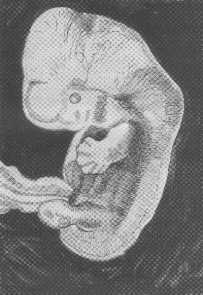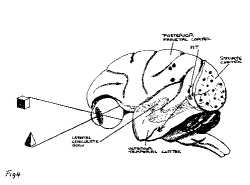|
Understanding the Brain in the 21st Century
by Max R. Bennett with illustrations by Gillian Bennett
In 1944, during the second world war, Erwin Schrodinger working in Dublin published a book which had an enormous influence on the history of biological science in the second half of the twentieth century (figure l). Schrodinger, together with Heisenberg, had created in 1926 the theory of quantum mechanics which was the most revolutionary concept in the history of the physical sciences. Towards the end of the thirties Schrodinger turned his mind to the question of what are our physical origins. He therefore started to consider the structure of genes and the extent to which our development occurs as a consequence of the unfolding of the information in genes. It was not known what the genetic material was made of at the time that Schrodinger wrote his book "What is Life". The guess at that stage was that it was made of protein and it was only shortly after the appearance of Schrodinger's book that it was discovered by an elderly gentleman working in the Rockefeller Institute in New York, Oswald Avery, that the genetic material was made of deoxyribonucleic acid (DNA). What Schrodinger's little book did was to bridge the revolution in physics that occurred in the first part of the century to the new revolution that was to dominate the second part of the century, namely molecular biology. Schrodinger conjectured in his book that there must be a code in the genes which is read out by the cell as a set of instructions that guide its, differentiation so as to give rise to the structure of the human embryo and therefore to our further development. In this way Schrodinger developed the concept of a genetic code, one of the most fruitful ideas in biology. Furthermore he speculated that the structure of the genetic code should be susceptible to physical analysis by means of such new techniques as crystallography. Crystallography had been developed as a science in the United Kingdom by the Braggs, father and son; they were from Adelaide and had won the Nobel Prize together in 1915.
 |
 |
| Figure 1. [Click on image for larger version] Erwin Schrodinger (1887-1961), the co-founder with Werner Heisenberg of quantum mechanics, and the author of the small book "What is life" in 1944. Schrodinger was in his thirties when he formulated one of the most revolutionary theories of matter in the history of physics. Many, such as the English mathematician Roger Penrose, believe that quantum mechanics holds the answer to the question of what is consciousness, an issue which Schrodinger wrote on extensively himself, especially in his small book "Mind and Matter". The theory of quantum mechanics was brought to a high degree of development by the American physicist Richard Feynman in 1952, with his ideas on how light and matter interact. In his late fifties Schrodinger, inspired by the youthful theoretical physicist who had come over to biology, Max Delbruck, penned "What is life". This speculated on the basis of hereditary and included the revolutionary ideas that the chromosome contained a "genetic code" laid out along its length which constitutes an imprint of the information needed to be read for the formation and functioning of the species. Schrodinger also suggested that the code could be understood at the atomic level providing the chromosomal material can be crystallized as an aperiodic crystal, capable of being subjected to the techniques of X–ray crystallography. These prescient suggestions were to bring some brilliant young physicists into biology, such as Crick and Randall. |
Figure 2. [Click on image for larger version] Francis Crick (born in 1916) was a young physicist who came into biology shortly after the publication of Schrodinger's book "What is life" in 1944. He became the leading intellectual force in interpreting the crystallographic data on the chromosomal material, Dioxyribonucleic acid (DNA), that lead to its known atomic structure in 1952; secondly he designed experiments that solved the genetic code by which DNA gives rise to specific proteins. These ideas helped lay the foundations of molecular Biology, the dominant area of science in the second half of the twentieth century. in this way Crick brought to fruition the research plan of Schrodinger. Crick now works in Brain Research and in his recent autobiography (1988) "What Mad Pursuit" speculates on how we are going to understand the origins of consciousness. Crick suggests that the clues to understanding this phenomena, so dear to us all, are to be found in the attentional mechanisms of the brain by which we concentrate our sensory and motor systems on some element of our environment, to the exclusion of all else in the environment. He also believes that as the memory of some thing attended to lasts for only about 60 seconds or so, then the molecular and atomic mechanisms involved should have only this time scale of change. |
After the second World War some of the brightest physicists decided not to go into Theoretical Physics but instead to try their hand at Biology. The end of the heroic period in Physics, which had been dominated by quantum mechanics, occurred about 1948 when Richard Feynman working at Cornell developed the theory which is referred to as Quantum Electrodynamics; this provides a description of how light interacts with matter. It is somewhat fortuitous that only a year after Richard Feynman had developed his theory, bringing quantum mechanics to its highest point of development, that a physicist named Frances Crick began working in the laboratory of the Braggs in Cambridge in 1949 (figure 2). Schrodinger's book had a major influence in Crick making this move. Together with a young and somewhat eccentric American called James Watson he applied the concepts of crystallography to the task of unravelling the detailed structure of DNA itself in 1951. In this way he furthered the research programme in the laboratory of the Braggs laid down by Schrodinger some five years earlier. To some extent the famous paper by Watson and Crick, published in Nature in 1953, completed the research aims of Schrodinger's book by indicating that the structure of the DNA molecule held within it the clues to its own replication. The last forty years of science have been dominated by molecular biology which has as part of its foundations these observations by Watson and Crick made in the Cavendish Laboratory at Cambridge run by Sir Lawrence Bragg from Adelaide.
In 1988 Crick, like Schrodinger before him, published a book that is likely to have far reaching effects on the future of research as young scientists see it. Crick suggests in "What Mad Pursuit" that the great challenge for science in the next century is not to be found in quantum mechanics, nor in molecular biology, but in the understanding of what it is that develops in the brain of human embryos that gives rise to consciousness (figure 3).
 |
 |
| Figure 3. [Click image for larger version] A human embryo at 5 weeks after conception (ll mm long). The hands and legs are already formed but there is only a hint of the digits. The body is clearly connected to an umbilical cord. The brain is developing above the eyes (to their left). The spinal cord is also clearly delineated. The adult brain has some 100,000,000,000 neurons, many of which have about 10,000 connections (or synapses) on them from other neurons. This results in some 100 million million synapses in the brain. As these synapses are capable of modifying their properties according to experience there is a truly wondrous range of possibilities in the wiring of the brain. |
Figure 4. [Click image for larger version] The main pathways in the brain concerned with the visual identification of objects and their location and movement in space. A coloured triangular form is observed moving in the visual field. The information about colour and form of an object on the one hand and about the movement of the object on the other are coded for separately within the retina of the eye. This coded information is then sent in parallel pathways along separate sets of axons, first to a part of the brain called the dorsal lateral geniculate nucleus and from there to the primary visual (striate) cortex in the occipital lobe at the back of the head. Here the coded information undergoes a transformation into the elements that recognisably belong to the object in the medial temporal area (MT) just in front of the striate visual cortex; at this site neurones fire in relation to seeing each of these elements. The other parallel line of coded information is sent to the posterior parietal cortex, also in front of the striate cortex, where neurons fire in relation to the movement of the object. The final pathway for the identification of an object is in the inferior temporal cortex, where recenstruction of the complete object and its colour is carried out. Here specific neurones fire when the object is viewed. |
(责任编辑:泉水) |